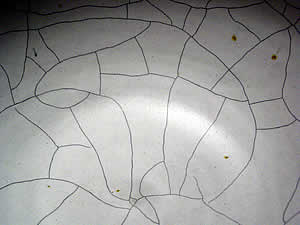 In the first part of the discussion on crazing we looked at the causes
of this phenomenon. We also introduced you to the concept of the coefficient
of expansion (COE) for individual oxides and for a glaze.
In the first part of the discussion on crazing we looked at the causes
of this phenomenon. We also introduced you to the concept of the coefficient
of expansion (COE) for individual oxides and for a glaze.
Although the factors that impact on crazing are quite complex we can
tackle the task of manipulating crazing by utilizing our knowledge of
the chemistry of a glaze.
Glaze software will calculate a coefficient of
expansion for a glaze which we can
use to help us determine what changes might produce more or less crazing.
The systems for calculating a coefficient of expansion for a glaze are
limited and far from perfect considering the complexities of the processes in the kiln. If however we are aware
of these limitations and use the numbers provided wisely, this coefficient
of expansion can be a very useful piece of information in controlling
what can be a very frustrating problem.
By controlling some of the issues associated with crazing we can produce
interesting decorative effects that can enhance our work.
In this lesson we will:
- examine limitations associated with the use of the coefficient of
expansion as a guide to controlling crazing.
- look at practical testing techniques that will enable us to utilize
C.O.E.s for glazes.
- formulate a strategy to tackle the task of reducing crazing
in glazes.

